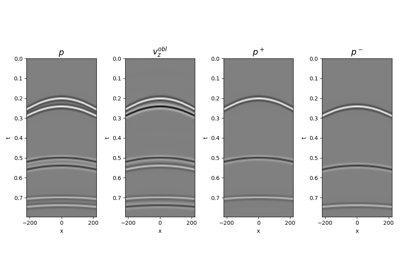pylops.waveeqprocessing.PressureToVelocity#
- pylops.waveeqprocessing.PressureToVelocity(nt, nr, dt, dr, rho, vel, nffts=(None, None, None), critical=100.0, ntaper=10, topressure=False, backend='numpy', dtype='complex128', name='P')[source]#
Pressure to Vertical velocity conversion.
Apply conversion from pressure to vertical velocity seismic wavefield (or vertical velocity to pressure). The input model and data required by the operator should be created by flattening the a wavefield of size \((\lbrack n_{r_y} \times n_{r_x} \times n_t \rbrack\).
- Parameters
- nt
int Number of samples along the time axis
- nr
intortuple Number of samples along the receiver axis (or axes)
- dt
float Sampling along the time axis
- dr
floatortuple Sampling(s) along the receiver array
- rho
float Density \(\rho\) along the receiver array (must be constant)
- vel
float Velocity \(c\) along the receiver array (must be constant)
- nffts
tuple, optional Number of samples along the wavenumber and frequency axes
- critical
float, optional Percentage of angles to retain in obliquity factor. For example, if
critical=100only angles below the critical angle \(\sqrt{k_y^2 + k_x^2} < \frac{\omega}{c}\) will be retained- ntaper
float, optional Number of samples of taper applied to obliquity factor around critical angle
- topressure
bool, optional Perform conversion from particle velocity to pressure (
True) or from pressure to particle velocity (False)- backend
str, optional Backend used for creation of obliquity factor operator (
numpyorcupy)- dtype
str, optional Type of elements in input array.
- name
str, optional New in version 2.0.0.
Name of operator (to be used by
pylops.utils.describe.describe)
- nt
- Returns
- Cop
pylops.LinearOperator Pressure to particle velocity (or particle velocity to pressure) conversion operator
- Cop
See also
UpDownComposition2D2D Wavefield composition
UpDownComposition3D3D Wavefield composition
WavefieldDecompositionWavefield decomposition
Notes
A pressure wavefield \(p(x, t)\) can be converted into an equivalent vertical particle velocity wavefield \(v_z(x, t)\) by applying the following frequency-wavenumber dependant scaling [1]:
\[\hat{v}_z(k_x, \omega) = \frac{k_z}{\omega \rho} \hat{p}(k_x, \omega)\]where the vertical wavenumber \(k_z\) is defined as \(k_z=\sqrt{\frac{\omega^2}{c^2} - k_x^2}\).
Similarly a vertical particle velocity can be converted into an equivalent pressure wavefield by applying the following frequency-wavenumber dependant scaling [1]:
\[\hat{p}(k_x, \omega) = \frac{\omega \rho}{k_z} \hat{v}_z(k_x, \omega)\]For 3-dimensional applications the only difference is represented by the vertical wavenumber \(k_z\), which is defined as \(k_z=\sqrt{\frac{\omega^2}{c^2} - k_x^2 - k_y^2}\).
In both cases, this operator is implemented as a concatanation of a 2 or 3-dimensional forward FFT (
pylops.signalprocessing.FFT2orpylops.signalprocessing.FFTN), a weighting matrix implemented viapylops.basicprocessing.Diagonal, and 2 or 3-dimensional inverse FFT.
